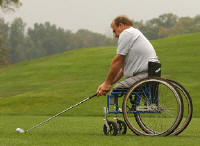
“Whenever any barrier stands between you and the full rights and dignity of citizenship, we must work to remove it, in the name of simple decency and justice. The promise of the ADA…has enabled people with disabilities to enjoy much greater access to a wide range of affordable travel, recreational opportunities and life-enriching services.”
President George W. Bush, New Freedom Initiative, February 1, 2001
Accessible Golf Courses
The recreation facility guidelines described in this guide focus on newly designed or newly constructed and altered golf courses and driving ranges. Other provisions contained in ADAAG address elements commonly found at a golf course, such as accessible vehicle parking spaces, exterior accessible routes, and toilet and bathing facilities. ADAAG addresses only the built environment (structures and grounds). The guidelines do not address operational issues. Questions regarding operational issues should be directed to the Department of Justice, 1-800-514-0301 or 1-800-514-0383 (TTY).
Accessible Routes
Accessible routes are continuous, unobstructed paths connecting all accessible elements and spaces of a building or facility on golf courses. The accessible route must comply with ADAAG provisions for location, width (minimum of 36 inches), passing space, head room, surface, slope (maximum of 1:12 or 8.33%), changes in level, doors, egress, and areas of rescue assistance, unless modified by specific provisions outlined in this guide.
Click on diagram to view enlargement.
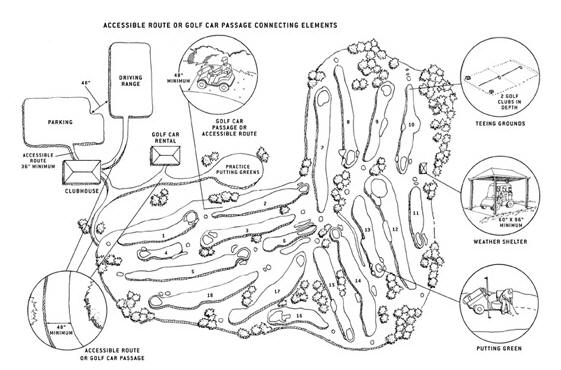
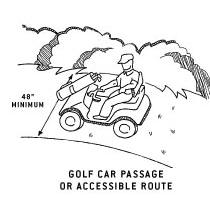
Alternative Golf Car Passage
Providing an accessible route that complies with ADAAG may be impractical throughout a golf course for several reasons. First, the route of play for a golfer is dependent on where the ball lands and is therefore unpredictable. The guidelines assume that on many courses, golfers use a golf car to move throughout the course.

Second, requiring an accessible route throughout a course could alter the slopes within some courses and alter the nature of the sport by eliminating some of the challenge of the game. Therefore, a golf car passage may be substituted for an accessible route within the boundary of a golf course. A golf car passage is a continuous passage on which a motorized golf car can operate. While a golf car passage must be usable by golf cars, it does not necessarily need to have a prepared surface and may be part of a golf car path.
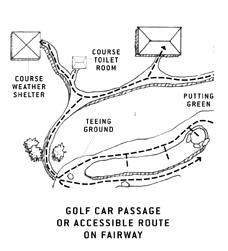
The golf car passage could be located on areas such as fairways, greens, and teeing surfaces. A golf car passage can be substituted for all or part of the accessible route connecting elements within the boundary of the course and must be a minimum of 48 inches in width.
A golf car passage may also be substituted for an accessible route outside the boundary of the golf course when connecting certain elements. This is limited to the golf car rental area, bag drop areas, practice putting greens, accessible practice teeing grounds, course toilet rooms, and course weather shelters.
Accessible Route Guidelines
Where an accessible route is used, the golf course guidelines modify ADAAG’s accessible route provisions. They increase the minimum width for an accessible route from 36 inches to 48 inches. If an accessible route is provided instead of a golf car passage, it must connect accessible elements and spaces located within the boundary of a golf course. The 48-inch minimum width for the accessible route is necessary to ensure passage of a golf car on the accessible route. This is important where the accessible route is used to connect the golf car rental area, bag drop areas, practice putting greens, accessible practice teeing grounds, course toilet rooms, and course weather shelters. These are areas outside the boundary of the golf course, but are areas where an individual using an adapted golf car may travel. Where handrails are provided along an accessible route, the guidelines increase the minimum width of the route to 60 inches to accommodate the passage of a golf car.
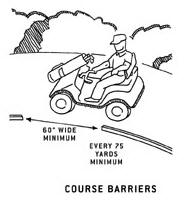
Course Barriers
Curbing or other man-made barriers often line golf car paths to restrict golf cars from entering certain portions of the course or to reduce erosion. Where man-made barriers are provided that prevent golf cars from entering a fairway, openings at least 60 inches wide at intervals not exceeding 75 yards must be provided. These dispersed openings will provide access to the course at reasonable intervals, enabling a golfer using a golf car to play the game without extended travel distances and time requirements.
Teeing Grounds
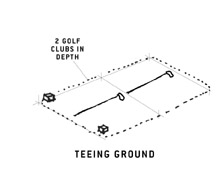 The "teeing ground" is the starting place for a hole of golf. A
rectangular area usually two club-lengths in depth, the teeing ground’s
borders are defined by the outside limits of two “tee-markers.” The
design and construction of new teeing grounds or the alteration of an
existing teeing area must allow golf cars to enter and exit within these
limits.
The "teeing ground" is the starting place for a hole of golf. A
rectangular area usually two club-lengths in depth, the teeing ground’s
borders are defined by the outside limits of two “tee-markers.” The
design and construction of new teeing grounds or the alteration of an
existing teeing area must allow golf cars to enter and exit within these
limits.
-
Forward Teeing Ground—The forward teeing ground for each hole must be connected by either an accessible route or a golf car passage. Existing courses do not have to provide access to the forward teeing ground in alterations, if terrain makes compliance infeasible.\
-
Multiple Teeing Grounds—If one or two teeing grounds are provided for a hole, only the forward teeing ground must be accessible either by an accessible route or a golf car passage. If three or more teeing grounds are provided for a hole, two teeing grounds must be accessible. This will allow persons with disabilities to play from different tees appropriate to their skill level, while providing flexibility to course operators and designers.
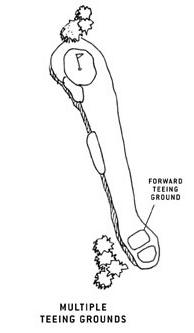
Putting Greens
Each putting green must be designed and constructed so that a golf car can
enter and exit the green. The green must be connected by a golf car
passage so that a golf car can reach the green.
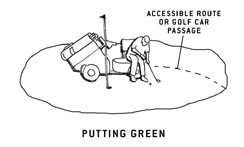
Weather Shelters
Course weather shelters must be designed and constructed to allow a golf car to
enter and exit, and have a clear floor or ground space of 60 inches by
96 inches minimum. This space will allow a golf car to be driven
directly into a weather shelter.
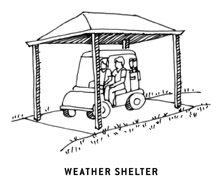
Driving Ranges
Both stand-alone driving ranges and driving ranges adjacent to a golf course that provide teeing stations or practice teeing grounds must comply with the following:
-
Accessible Routes—An accessible route or a golf car passage must connect accessible teeing stations with accessible parking spaces. The accessible route must be a minimum of 48 inches wide. If handrails are provided, the accessible route must be a minimum of 60 inches wide. This will allow a person who plays golf from a golf car to practice driving a golf ball from the same position and stance used when playing the game.
-
Teeing Stations—If teeing stations or practice teeing grounds are provided, at least five percent, but not less than one, of the practice teeing grounds must be accessible and provide space for a golf car to enter and exit.

Single Rider Adaptive Golf Cars
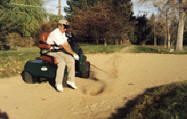 In recent years, single rider adaptive golf cars have been used to increase
access for persons with disabilities on golf courses. Questions have
arisen concerning their use. The Access Board develops and maintains
accessibility guidelines for the built environment. It is outside the
jurisdiction of the Access Board to address operational issues such as
the use of these cars. Operators should contact the Department of
Justice at 1-800-514-0301 or 1-800-514-0383 (TTY) regarding issues
relating to the use and operation of adaptive golf cars.
In recent years, single rider adaptive golf cars have been used to increase
access for persons with disabilities on golf courses. Questions have
arisen concerning their use. The Access Board develops and maintains
accessibility guidelines for the built environment. It is outside the
jurisdiction of the Access Board to address operational issues such as
the use of these cars. Operators should contact the Department of
Justice at 1-800-514-0301 or 1-800-514-0383 (TTY) regarding issues
relating to the use and operation of adaptive golf cars.
Temporary Facilities
 ADAAG also requires temporary facilities such as bleachers for tournaments,
assembly seating areas, portable toilet facilities, concessions, and all
other available amenities to provide access. Access to temporary
facilities on a golf course may be achieved through either an accessible
route or golf car passage. Facilities hosting tournaments or
competitions must comply with all the other requirements of the ADA,
including the general obligation to provide an equal opportunity to
individuals with disabilities to enjoy the services provided.
ADAAG also requires temporary facilities such as bleachers for tournaments,
assembly seating areas, portable toilet facilities, concessions, and all
other available amenities to provide access. Access to temporary
facilities on a golf course may be achieved through either an accessible
route or golf car passage. Facilities hosting tournaments or
competitions must comply with all the other requirements of the ADA,
including the general obligation to provide an equal opportunity to
individuals with disabilities to enjoy the services provided.
Provision Index
This table highlights the sections of the ADA and ABA Accessibility Standards discussed in the amusement rides guide.
| ADA Standards* | ABA Standards | |
| Definitions | 106.5 | F106.5 |
| Cross Slope | 106.5 | F106.5 |
| Curb Ramp | 106.5 | F106.5 |
| Facility | 106.5 | F106.5 |
| Golf Car Passage | 106.5 | F106.5 |
| Ramp | 106.5 | F106.5 |
| Running Slope | 106.5 | F106.5 |
| Teeing Ground | 106.5 | F106.5 |
| Golf Facilities (where provided) | 238 | F238 |
| Golf Courses | 238.2 | F238.2 |
| Putting Greens | 238.2.2 | F238.2.2 |
| Teeing Grounds | 238.2.1 | F238.2.1 |
| Weather Shelters | 238.2.3 | F238.2.3 |
| Practice Putting Greens, Teeing Grounds, and Stations at Driving Ranges | 238.3 | F238.3 |
| Accessible Routes (where required) | 206 | F206 |
| Golf Course (specific provision) | 206.2.15 | F206.2.15 |
| Golf Car Passage (exception) | 206.2.15 EX | F206.2.15 EX |
| Accessible Routes Components (typically used) | ||
| Curb Ramps | 406 | 406 |
| Doors and Gates | 404 | 404 |
| Handrails (exception) | 1006.2 EX | 1006.2 EX |
| Ramps | 405 | 405 |
| Walking Surfaces with Running Slopes of 5% or less | 403 | 403 |
| Width Modification (when connecting certain features) | 1006.2 | 1006.2 |
| Technical Requirements for Golf Car Passage | 1006.3 | 1006.3 |
| Clear Width | 1006.3.1 | 1006.3.1 |
| Course Barriers | 1006.3.2 | 1006.3.2 |
| Technical Requirements for Golf Courses | 1006 | 1006 |
| Weather Shelter | 1006.4 | 1006.4 |
| Other Typical Scoping Requirements at Fishing Facilities | ||
| Dining surfaces | 226 | F226 |
| Employee Work Areas (exception) | 203.9 | no similar exception |
| Locker Rooms | 222 | F222 |
| Parking | 208 | F208 |
| Passenger Loading Zones and Bus Stops | 209 | F209 |
| Service Counter | 227.3 | F227.3 |
| Signage | 216 | F216 |
| Spectator Seating | 221 | F221 |
| Temporary Facilities | 201.3 | F201.3 |
| Toilet and Bathing | 213 | F213 |
| Vending Machines | 228 | F228 |
* The guide uses the term ADAAG (Americans with Disabilities Act Accessibility Guidelines) as the basis of the requirements discussed. The recreational provisions of these guidelines were adopted into the 2010 ADA Standards without changes, so the ADAAG section numbers correspond to the same section numbers in the ADA Standards (as well as the Architectural Barriers Act (ABA) Accessibility Standards).




